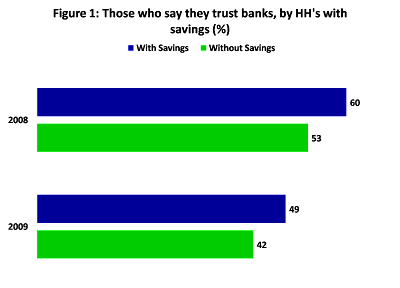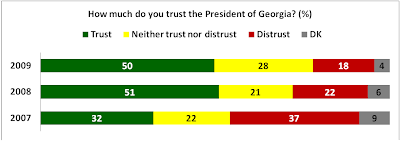In running an election-day survey (not an exit poll, which we are not so enthused about), we have decided to attempt something new: we are now aggregating the information via SMS. This gives us the information in real time, and…
Blog
Here you can find blogs written by researchers at CRRC Georgia that analyse trends in the region and are mainly based on the survey data conducted by CRRC Georgia. These articles first appear on OC Media’s Caucasus Data Blog as part of the collaboration between CRRC Georgia and OC Media.

Banking is one of the fastest-growing sectors of the Georgian economy, a point which was underlined in a 2009 report from the Ministry of Economic Development of Georgia. But does this development mean that society views banks as trustworthy partners…
The CRRC’s annual Data Initiative Survey will be renamed into the Caucasus Barometer starting from 2010. At CRRC, we think that the new name better reflects the essence of the survey and is more understandable for the general public and…

During the last two decades, Georgia has created new government institutions designed to serve as the tools and safeguards of democracy. But do Georgians believe that these institutions live up to their mission statements? How much do Georgians trust government…
On 15 April, in front of a packed house at the Heinrich Böll Foundation in Tbilisi, Ron Asmus led a public debate on his new book, A Little War that Shook the World. The evening featured the kind of discussion…
Last month we wrote a blog post on gender imbalance in the South Caucasus showing that there is an abnormal high number of boys being born in the region. Several comments were posted on the blog site that brought attention…
On 29 March the Norwegian Refugee Council (NRC) held a presentation in Tbilisi of the research report “Not Displaced, Out-of-Place – Education of IDP children in Georgia”. The research project examines the academic performance of children in so-called Abkhaz public IDP schools…
In 2007 we wrote a blog post on the Big Mac Index, an index published by The Economist as an informal way of measuring purchasing power parity (PPP). The idea is that a dollar should buy you the same amount in all…
Earlier this month The Economist published two articles (article one, article two) on imbalances in gender. In all societies there is, at birth, a sex ratio slightly biased in favor of boys: 103-106 boys to 100 girls. The number evens out later on…
